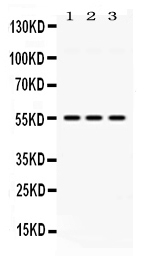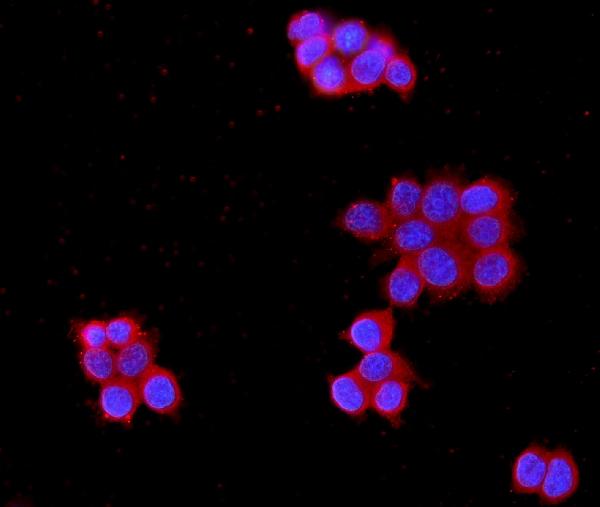Product Info Summary
| SKU: | PB10078 |
|---|---|
| Size: | 100 μg/vial |
| Reactive Species: | Human, Mouse, Rat |
| Host: | Rabbit |
| Application: | IF, ICC, WB |
Customers Who Bought This Also Bought
Product info
Product Name
Anti-MPP1 Antibody Picoband®
SKU/Catalog Number
PB10078
Size
100 μg/vial
Form
Lyophilized
Description
Boster Bio Anti-MPP1 Antibody Picoband® catalog # PB10078. Tested in IF, ICC, WB applications. This antibody reacts with Human, Mouse, Rat. The brand Picoband indicates this is a premium antibody that guarantees superior quality, high affinity, and strong signals with minimal background in Western blot applications. Only our best-performing antibodies are designated as Picoband, ensuring unmatched performance.
Storage & Handling
Store at -20˚C for one year from date of receipt. After reconstitution, at 4˚C for one month. It can also be aliquotted and stored frozen at -20˚C for six months. Avoid repeated freeze-thaw cycles.
Cite This Product
Anti-MPP1 Antibody Picoband® (Boster Biological Technology, Pleasanton CA, USA, Catalog # PB10078)
Host
Rabbit
Contents
Each vial contains 5mg BSA, 0.9mg NaCl, 0.2mg Na2HPO4, 0.01mg NaN3.
Clonality
Polyclonal
Isotype
Rabbit IgG
Immunogen
A synthetic peptide corresponding to a sequence at the C-terminus of human MPP1, different from the related mouse sequence by one amino acid.
*Blocking peptide can be purchased. Costs vary based on immunogen length. Contact us for pricing.
Cross-reactivity
No cross-reactivity with other proteins.
Reactive Species
PB10078 is reactive to MPP1 in Human, Mouse, Rat
Reconstitution
Add 0.2ml of distilled water will yield a concentration of 500ug/ml.
Observed Molecular Weight
55 kDa
Calculated molecular weight
52296 MW
Background of MPP1
55 kDa erythrocyte membrane protein is a protein that in humans is encoded by the MPP1 gene. This gene encodes the prototype of the membrane-associated guanylate kinase (MAGUK) family proteins. MAGUKs interact with the cytoskeleton and regulate cell proliferation, signaling pathways, and intercellular junctions. The encoded protein is an extensively palmitoylated membrane phosphoprotein containing a PDZ domain, a Src homology 3 (SH3) motif, and a guanylate kinase domain. This gene product interacts with various cytoskeletal proteins and cell junctional proteins in different tissue and cell types, and may be involved in the regulation of cell shape, hair cell development, neural patterning of the retina, and apico-basal polarity and tumor suppression pathways in non-erythroid cells. Multiple transcript variants encoding different isoforms have been found for this gene.
Antibody Validation
Boster validates all antibodies on WB, IHC, ICC, Immunofluorescence, and ELISA with known positive control and negative samples to ensure specificity and high affinity, including thorough antibody incubations.
Application & Images
Applications
PB10078 is guaranteed for IF, ICC, WB Boster Guarantee
Assay Dilutions Recommendation
The recommendations below provide a starting point for assay optimization. The actual working concentration varies and should be decided by the user.
Western blot, 0.1-0.5μg/ml, Human, Mouse, Rat
Immunocytochemistry/Immunofluorescence, 2μg/ml, Human
Positive Control
WB: rat lung tissue, mouse spleen tissue, MCF-7 whole cell
ICC/IF: MCF7 cell
FCM: U87 cell
Validation Images & Assay Conditions

Click image to see more details
Figure 1. Western blot analysis of MPP1 using anti-MPP1 antibody (PB10078).
Electrophoresis was performed on a 5-20% SDS-PAGE gel at 70V (Stacking gel) / 90V (Resolving gel) for 2-3 hours. The sample well of each lane was loaded with 30 ug of sample under reducing conditions.
Lane 1: rat lung tissue lysates,
Lane 2: mouse spleen tissue lysates,
Lane 3: MCF-7 whole cell lysates.
After electrophoresis, proteins were transferred to a nitrocellulose membrane at 150 mA for 50-90 minutes. Blocked the membrane with 5% non-fat milk/TBS for 1.5 hour at RT. The membrane was incubated with rabbit anti-MPP1 antigen affinity purified polyclonal antibody (Catalog # PB10078) at 0.5 μg/mL overnight at 4°C, then washed with TBS-0.1%Tween 3 times with 5 minutes each and probed with a goat anti-rabbit IgG-HRP secondary antibody at a dilution of 1:5000 for 1.5 hour at RT. The signal is developed using an Enhanced Chemiluminescent detection (ECL) kit (Catalog # EK1002) with Tanon 5200 system. A specific band was detected for MPP1 at approximately 55 kDa. The expected band size for MPP1 is at 52 kDa.

Click image to see more details
Figure 2. IF analysis of MPP1 using anti-MPP1 antibody (PB10078).
MPP1 was detected in immunocytochemical section of MCF7 cells. Enzyme antigen retrieval was performed using IHC enzyme antigen retrieval reagent (AR0022) for 15 mins. The cells were blocked with 10% goat serum. And then incubated with 2μg/mL rabbit anti-MPP1 Antibody (PB10078) overnight at 4°C. DyLight®594 Conjugated Goat Anti-Rabbit IgG (BA1142) was used as secondary antibody at 1:100 dilution and incubated for 30 minutes at 37°C. The section was counterstained with DAPI. Visualize using a fluorescence microscope and filter sets appropriate for the label used.
Protein Target Info & Infographic
Gene/Protein Information For MPP1 (Source: Uniprot.org, NCBI)
Gene Name
MPP1
Full Name
55 kDa erythrocyte membrane protein
Weight
52296 MW
Superfamily
MAGUK family
Alternative Names
55 kDa erythrocyte membrane protein;p55;Membrane protein, palmitoylated 1;MPP1;DXS552E, EMP55; MPP1 AAG12, DXS552E, EMP55, MRG1, PEMP membrane palmitoylated protein 1 55 kDa erythrocyte membrane protein|aging-associated gene 12|erythrocyte membrane protein p55|membrane protein, palmitoylated 1, 55kDa|migration-related gene 1|p55|palmitoylated erythrocyte membrane protein
*If product is indicated to react with multiple species, protein info is based on the gene entry specified above in "Species".For more info on MPP1, check out the MPP1 Infographic

We have 30,000+ of these available, one for each gene! Check them out.
In this infographic, you will see the following information for MPP1: database IDs, superfamily, protein function, synonyms, molecular weight, chromosomal locations, tissues of expression, subcellular locations, post-translational modifications, and related diseases, research areas & pathways. If you want to see more information included, or would like to contribute to it and be acknowledged, please contact [email protected].
Specific Publications For Anti-MPP1 Antibody Picoband® (PB10078)
Hello CJ!
PB10078 has been cited in 1 publications:
*The publications in this section are manually curated by our staff scientists. They may differ from Bioz's machine gathered results. Both are accurate. If you find a publication citing this product but is missing from this list, please let us know we will issue you a thank-you coupon.
Chen Y,Griffiths A,Wang J,Zhang T,Song Q,Song Z.Inositol-requiring enzyme 1α links palmitate-induced mTOR activation and lipotoxicity in hepatocytes.Am J Physiol Cell Physiol.2020 Dec 1;319(6):C1130-C1140.doi: 10.1152/ajpcell.00165.2020.Epub 2020 Oct 14.P
Species: Human,Mouse
PB10078 usage in article: APP:WB, SAMPLE:HEPG2 CELL AND AML12 CELL, DILUTION:NA
Recommended Resources
Here are featured tools and databases that you might find useful.
- Boster's Pathways Library
- Protein Databases
- Bioscience Research Protocol Resources
- Data Processing & Analysis Software
- Photo Editing Software
- Scientific Literature Resources
- Research Paper Management Tools
- Molecular Biology Software
- Primer Design Tools
- Bioinformatics Tools
- Phylogenetic Tree Analysis
Customer Reviews
Have you used Anti-MPP1 Antibody Picoband®?
Submit a review and receive an Amazon gift card.
- $30 for a review with an image
0 Reviews For Anti-MPP1 Antibody Picoband®
Customer Q&As
Have a question?
Find answers in Q&As, reviews.
Can't find your answer?
Submit your question
7 Customer Q&As for Anti-MPP1 Antibody Picoband®
Question
Does PB10078 anti-MPP1 antibody work on parafin embedded sections? If so, which fixation method do you recommend we use (PFA, paraformaldehyde, other)?
Verified Customer
Verified customer
Asked: 2020-02-25
Answer
You can see on the product datasheet, PB10078 anti-MPP1 antibody as been validated on WB. It is best to use PFA for fixation because it has better tissue penetration ability. PFA needs to be prepared fresh before use. Long term stored PFA turns into formalin, as the PFA molecules congregate and become formalin.
Boster Scientific Support
Answered: 2020-02-25
Question
Is a blocking peptide available for product anti-MPP1 antibody (PB10078)?
Verified Customer
Verified customer
Asked: 2020-02-20
Answer
We do provide the blocking peptide for product anti-MPP1 antibody (PB10078). If you would like to place an order for it please contact [email protected] and make a special request.
Boster Scientific Support
Answered: 2020-02-20
Question
I am interested in to test anti-MPP1 antibody PB10078 on human erythroleukemia for research purposes, then I may be interested in using anti-MPP1 antibody PB10078 for diagnostic purposes as well. Is the antibody suitable for diagnostic purposes?
Verified Customer
Verified customer
Asked: 2019-11-04
Answer
The products we sell, including anti-MPP1 antibody PB10078, are only intended for research use. They would not be suitable for use in diagnostic work. If you have the means to develop a product into diagnostic use, and are interested in collaborating with us and develop our product into an IVD product, please contact us for more discussions.
Boster Scientific Support
Answered: 2019-11-04
Question
Is this PB10078 anti-MPP1 antibody reactive to the isotypes of MPP1?
Verified Customer
Verified customer
Asked: 2019-10-08
Answer
The immunogen of PB10078 anti-MPP1 antibody is A synthetic peptide corresponding to a sequence at the C-terminus of human MPP1 (409-450aa TEALQQLQKDSEAIRSQYAHYFDLSLVNNGVDETLKKLQEAF), different from the related mouse sequence by one amino acid. Could you tell me which isotype you are interested in so I can help see if the immunogen is part of this isotype?
Boster Scientific Support
Answered: 2019-10-08
Question
We are currently using anti-MPP1 antibody PB10078 for rat tissue, and we are happy with the WB results. The species of reactivity given in the datasheet says human, mouse, rat. Is it true that the antibody can work on primate tissues as well?
A. Gonzalez
Verified customer
Asked: 2019-05-28
Answer
The anti-MPP1 antibody (PB10078) has not been validated for cross reactivity specifically with primate tissues, though there is a good chance of cross reactivity. We have an innovator award program that if you test this antibody and show it works in primate you can get your next antibody for free. Please contact me if I can help you with anything.
Boster Scientific Support
Answered: 2019-05-28
Question
Will anti-MPP1 antibody PB10078 work for WB with erythroleukemia?
C. Huang
Verified customer
Asked: 2018-12-04
Answer
According to the expression profile of erythroleukemia, MPP1 is highly expressed in erythroleukemia. So, it is likely that anti-MPP1 antibody PB10078 will work for WB with erythroleukemia.
Boster Scientific Support
Answered: 2018-12-04
Question
My question regarding product PB10078, anti-MPP1 antibody. I was wondering if it would be possible to conjugate this antibody with biotin. I would need it to be without BSA or sodium azide. I am planning on using a buffer exchange of sodium azide with PBS only. Would there be problems for me to conjugate the antibody and store it in -20 degrees in small aliquots?
E. Thomas
Verified customer
Asked: 2014-10-23
Answer
It is not recommended storing this antibody with PBS buffer only in -20 degrees. If you want to store it in -20 degrees it is best to add some cryoprotectant like glycerol. If you want carrier free PB10078 anti-MPP1 antibody, we can provide it to you in a special formula with trehalose and/or glycerol. These molecules will not interfere with conjugation chemistry and provide a good level of protection for the antibody from degradation. Please be sure to specify this in your purchase order.
Boster Scientific Support
Answered: 2014-10-23





